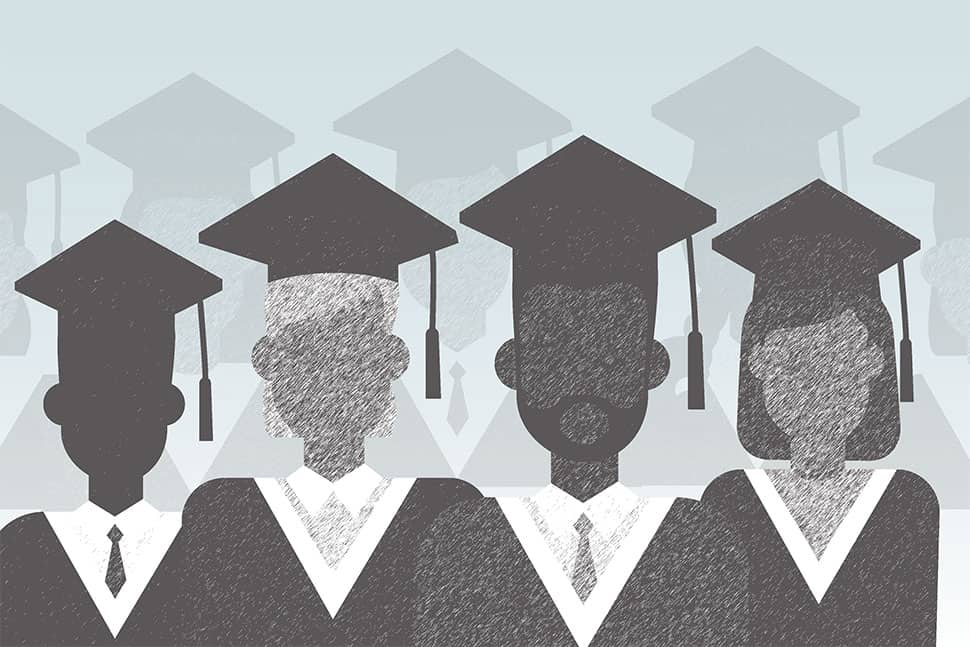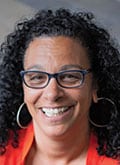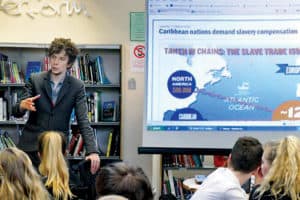
For librarians of all stripes, dissertations are an often-overlooked source of valuable information—information that has the potential to improve or even transform the institutions we serve. Dissertations, after all, are more than mere requirements for a doctoral degree; they’re original, substantial contributions to knowledge. Here we present eight of the year’s top LIS dissertations, each capable of shaping the practice of library and information science in a different way.
The students and their topics are:
- April Lynne Anderson (Iowa State University in Ames) examined information literacy programs in community colleges.
- Laura K. Clark (Florida State University in Tallahassee) explored the motivations of caregivers who bring children to emergent literacy programs in the public library.
- Sarah Clark (Oklahoma State University in Stillwater) investigated the ways in which undergraduates choose mediators when conducting information searches.
- Jeffrey Michael DiScala (University of Maryland, College Park) asked: “How are school librarians recruited and hired?”
- Diane M. Hamilton (State University of New York at Albany) studied one boy’s efforts to achieve meaning through picture books.
- Kelli Johnson (Marshall University in Huntington, West Virginia) examined the experiences of minority librarians through the lens of critical race theory.
- Dallas Long (Illinois State University in Normal) looked at partnerships between student-affairs professionals and librarians.
- Jennifer Sue Thiele (University of Wisconsin–Milwaukee) focused on the challenges rural libraries face when trying to keep their technology and internet speed up to date.
April Lynne Anderson
“Conceptualization and Practice of Information Literacy Instruction in Community Colleges”
PhD, Iowa State University

Summary: Through interviews, observations, and document analysis, Anderson sought to understand how information literacy is conceptualized and practiced in five community college libraries. The results showed that all sites offer quality instruction in information literacy. All sites conduct 50- to 70-minute educational sessions on search strategies for general information sources, information evaluation, and source citation. However, not all students are required to participate, and students who do not may find themselves at a disadvantage after transferring to a four-year school. Getting faculty buy-in is important for increasing the number of students who participate in this instruction. Librarians who proactively reach out to faculty about what the library can do for them and their students are more likely to obtain this buy-in.
Recommendations: Anderson recommends that librarians inform faculty about services and draw them into the library, perhaps by holding an open house for new faculty so they can learn how the library can support them in their classes. Other ideas include email discussions with departments and attendance at faculty meetings. Librarians can also structure information literacy instruction to address specific faculty and course needs, such as training on how to detect bias and power inequities in websites, news articles, commercials, images, texts, and other information sources. Students learn to not only ask questions but also to consider the purpose of the information, the intent of its creators, and the audience.
Laura K. Clark
PhD, Florida State University

Summary: Clark investigated caregivers’ perceptions of emergent literacy programming and their motivations for attending library programs for children up to age 3. Caregivers viewed library programs as important preparation for school (referring to the need for print awareness, listening skills, and vocabulary skills). Another motivating factor was that programs are free, which is especially helpful for low-income caregivers. Other motivations included socialization, since the programs provide a way for caregivers, especially first-time mothers, to interact and form social networks. Caregivers also believed that early learning should be fun and that the library programs were fun for children.
Recommendations: This study supports libraries providing good learning experiences through programming for children. Programs must motivate caregivers and children to attend, and librarians must create warm, caring, and supportive environments; develop responsive relationships with caregivers and children; coach caregivers on emergent literacy and early childhood development; and educate caregivers on library resources. Also, libraries must take the initiative in designing and marketing these programs to caregivers.
Sarah Clark
PhD, Oklahoma State University

Summary: Clark explored the thoughts, feelings, and actions of undergraduates who ask for help (mediation) with information searches. Formal mediators are defined as librarians and instructors of the course for which the information search is being conducted, while informal mediators comprise family, friends, colleagues, and subject-matter experts aside from instructors or professors. Clark found that while students knew the value of librarians as search mediators and appreciated the library instruction they provided, they nonetheless relied a great deal on informal mediators. The multiple-case study also found that information seekers selected mediators who they believed could address their needs; the ideal mediation encounter provided straightforward answers in a safe space; students typically used lessons learned via mediation to address perceived weaknesses in their information search abilities; mediation encounters varied widely depending on students’ goals for an assignment and influenced information-seeking behaviors in future searches; and effective mediation encounters focused on the seeker’s needs.
Recommendations: The study results suggest that librarians can advance search-mediation practice by building trusting relationships with students, such as by being more visible on campus, increasing outreach, and providing embedded librarian services. Personal connections may lead students to view librarians as supportive, knowledgeable mediators. Professional association tools should build awareness of mediation encounters from the user perspective.
Jeffrey Michael DiScala
PhD, University of Maryland, College Park

Summary: This multiple-case study examined the decision-making processes used by school districts to recruit and hire school librarians. DiScala looked at the process of hiring school librarians through a governance and best-fit model of hiring practices borrowed from IT research. In this view, principals know how to run the school, HR staff know district hiring policies and practices, and school librarians know how to manage a building-wide library program. The study showed that no districts required principals to include the library supervisor in the process of hiring school librarians. However, principals who included library supervisors in the hiring process reported that their input was valuable.
Recommendations: Practices and protocols for recruiting and hiring school librarians should be developed. A knowledge-sharing dialogue should be developed among the principal, HR staff, and library supervisor. Librarians should be included in the hiring process. Hiring qualified librarians will ensure that the library program offers the best resources and services for students to develop information, technology, and reading literacies. Further research needs to be conducted about the recruitment and hiring of school librarians.
Diane M. Hamilton
PhD, State University of New York at Albany

Summary: Hamilton set out to examine the connection between the potential of postmodern picture books (those with nonlinear, diverse perspectives) to affect change, the ways boys are socialized into literacy practices, and the problem of male disengagement from literacy. She examined one boy’s experiences with required reading of traditional and postmodern picture books. Hamilton analyzed data collected during a book sort, think-aloud readings, interviews with the participant and his family, and historical data from school records and tutoring records. The analysis showed that reading a traditional book entailed identifying the words, following an explicit storyline, and turning to the next page, that is, making meaning as intended by the author-authority. The participant responded to reading a postmodern picture book by making sense of unusual features, interacting with illustrations, and generating and revising meaning along the way. While the participant found postmodern picture books more entertaining, he often preferred traditional texts. The data suggests that experiencing postmodern picture books with a focus on think-aloud commentary may have changed his views on what it means to read.
Recommendations: The author suggests that children who struggle to read are experiencing incomplete conceptions of reading. Postmodern picture books may provide opportunities for changing reading behaviors. Children could be encouraged to choose a postmodern picture book to share in a think-aloud with parents, caregivers, and teachers. Hamilton further recommends providing books that represent a varied degree of traditional or postmodern characteristics (some may even be hybrid), books for a variety of ages, books with male and female main characters, and books that are stereotypically boy- and girl-friendly. Hamilton also recommends including a variety of intertextual references (some familiar and some likely to be unfamiliar) and storylines that promote exploration of identities and points of view and that challenge assumed norms and ideations.
Kelli Johnson
“Minority Librarians in Higher Education: A Critical Race Theory Analysis”
EdD, Marshall University

Summary: Through the lens of critical race theory, Johnson investigated the experiences of minority librarians in academic libraries. She found that the librarians shared a spirit of service and a commitment to activism, valued mentoring and networking during LIS education and in the workplace, endured daily injustices in higher education, and shared the love of libraries and reading. The study aims to help LIS schools, higher-education administrations, and professional library organizations attract and recruit minority librarians.
Recommendations: Acknowledging the importance of activism is one step toward creating an environment conducive to minority recruitment. Mentoring and networking opportunities can be stepped up as well as adjusted to include follow-through evaluation. LIS schools and higher education administrations can use surveys or other methods to determine campus- and program-level attitudes toward minorities. Staff and students can participate in awareness training, such as LGBT safe-space training. Finally LIS programs and professional organizations can develop recruitment strategies that target minority undergraduates in reading- or research-oriented disciplines.
Dallas Long
“Librarians and Student-Affairs Professionals as Collaborators for Student Learning and Success”
PhD, Illinois State University

Summary: Partnerships between student-affairs professionals and librarians are rare, despite the fact that they share the goal of college student success. Long used focus groups to identify how student-affairs professionals perceive librarians and vice versa. Long found no evidence of collaboration between student-affairs professionals and librarians at the four institutions studied but did find that the professional roles of student-affairs professionals and librarians do intersect and that their work differs in ways not conducive to collaboration. Whereas student-affairs professionals focus on students’ holistic development, librarians focus on fostering critical-thinking skills. Long found that the two groups did not share a common view of student learning, did not trust the other’s interpersonal skills or ability to plan, and had not considered collaborating.
Recommendations: For collaboration to take place between student-affairs professionals and librarians, change must occur at the administrative and staff levels. A campuswide educational philosophy that guides shared notions of student learning will promote better understanding between library and student-affairs departments. A system that rewards collaboration between student-affairs professionals and librarians can serve as incentive. At the staff level, someone must take the first step. Librarians can invite student-affairs staff to attend informal meetings to discuss their work. The two groups could take time to learn about their different roles in student learning, planning, and schedules, then work to find common ground. Librarians and student-affairs staff may find that their differences complement each other.
Jennifer Sue Thiele
PhD, University of Wisconsin–Milwaukee

Summary: Through interviews, surveys, and documents such as budget reports, Thiele examined issues related to information access in rural public libraries. Rural libraries often have challenges with staffing, internet connectivity, and funding. Many rural libraries do not have staff trained to develop and maintain the needed technology resources or to assist patrons with technology questions. Often this role is taken on by staff or even by volunteers with an interest in technology. Paid staff may be earning minimum wage and have few benefits; low wages make it difficult to hire and keep staff with proper technology training. Rural libraries do not have adequate funding or space to maintain up-to-date computers and technology resources. While all respondents reported increased broadband speed in the last few years, rural areas still often have limited broadband options.
Recommendations: At the local level, librarians can continue to advocate the need to hire qualified staff and to provide professional development for existing staff. In addition, rural libraries can participate in free training through resources such as OCLC’s WebJunction. The online training is available to staff and volunteers and features courses such as Enhancing Your Library’s Web Presence with WordPress, Innovation on a Shoestring, and IT Security for Libraries. Rural library staff should stay up to date with state policies and programs that support community and library technology; they can also lobby for improvements and continuation of federal programs such as the E-Rate program, which helps schools and libraries obtain affordable high-speed internet access and telecommunication rates, and Broadband USA, which assists libraries and communities in planning for better and faster internet access.

 KATHY ROSA is director of ALA’s Office for Research and Evaluation.
KATHY ROSA is director of ALA’s Office for Research and Evaluation.

What’s the methodology for determining the “top” dissertations?
Kathy Rosa, director of ALA’s Office for Research & Statistics, replies:
“There are many wonderful LIS dissertations each year. I locate and read dissertations via university digital archives and online databases. I select dissertations that have practical implications for school, public, academic and special libraries. Next, I look for a variety of methodologies, including quantitative, qualitative, and mixed methods approaches. Those most relevant to current issues and with measurable recommendations for change are then selected for the article.”
Thanks Kathy! I think it would be really helpful if you included this information in the article and future articles about featured dissertations.
Kathy Rosa replies:
“Good idea, Rachel! We will include the selection criteria in the future.”